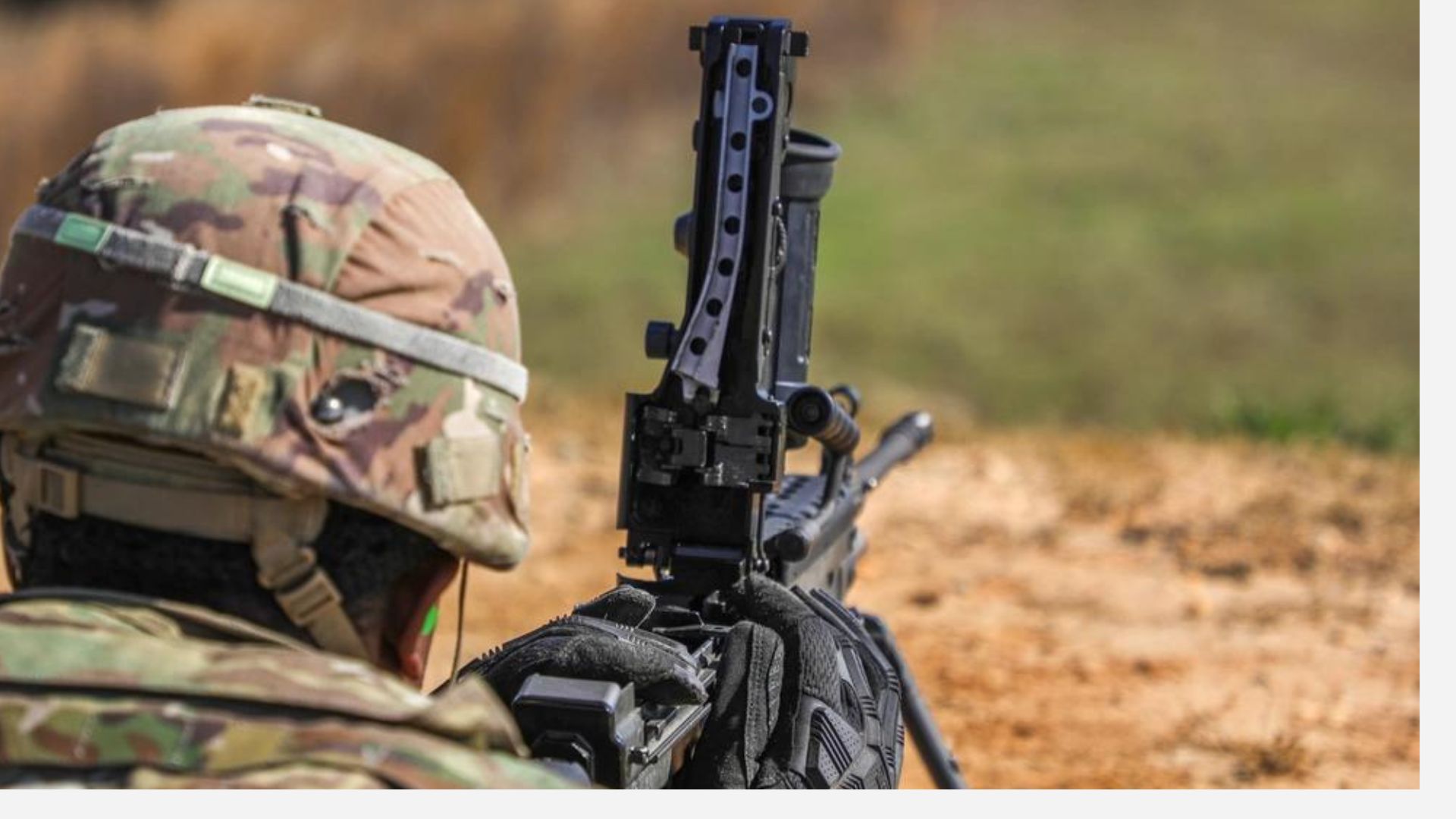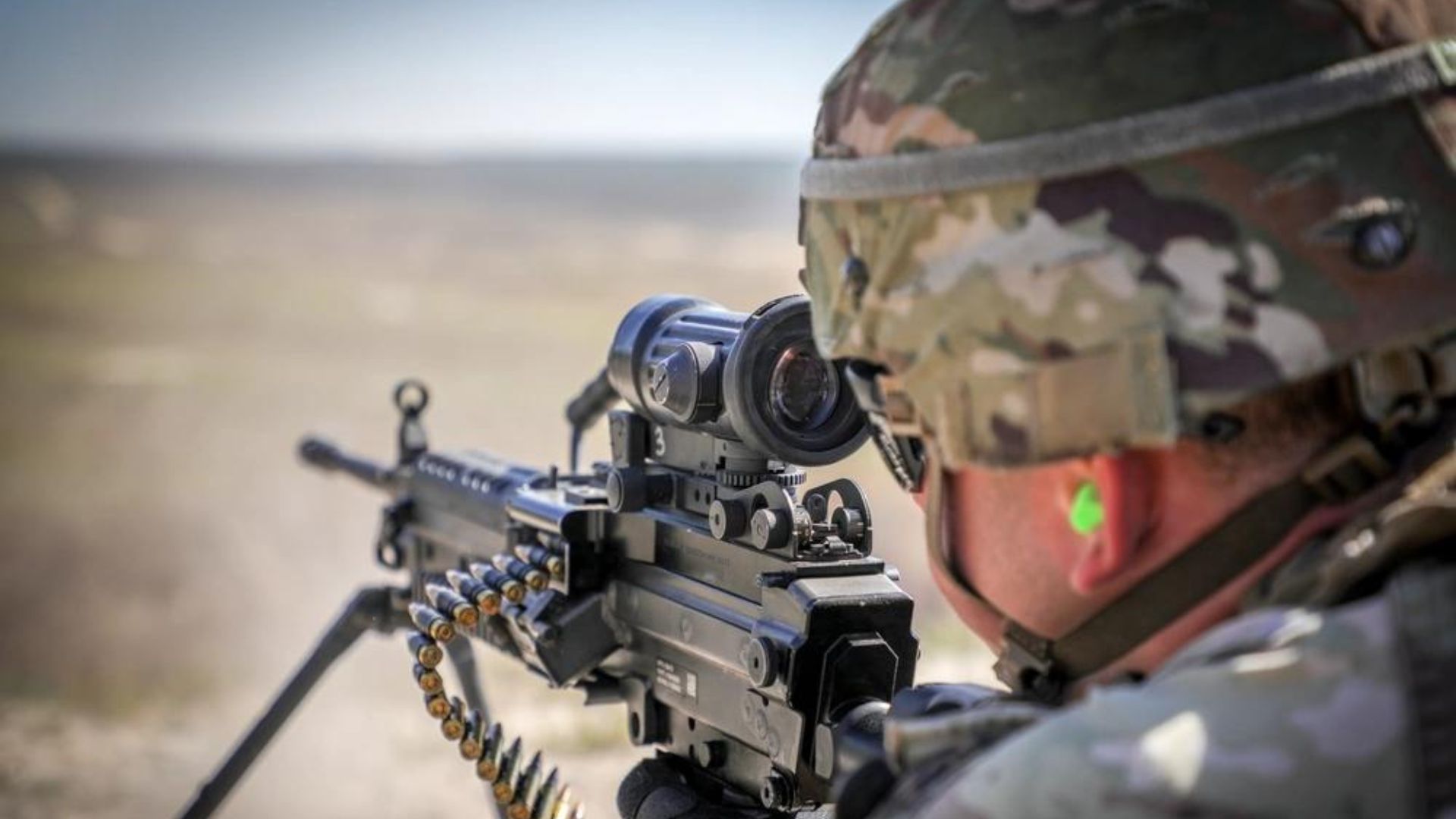Adopted by the U.S. military in 1984, the M249 SAW is a light machine gun that combines the rapid-fire capability of a machine gun with the portability of a rifle, making it a versatile asset on the battlefield. With a rate of fire between 750 and 1,000 rounds per minute, the M249 SAW ensures sustained suppressive fire, enhancing the effectiveness of infantry squads.
This article delves into the history, mechanics, and tactical advantages that make the M249 SAW a crucial element of America’s military arsenal.
A Brief Look
The M249 SAW (Squad Automatic Weapon), officially known as the Light Machine Gun, 5.56 mm, M249, is the U.S. adaptation of the Belgian FN Minimi.

This light machine gun, manufactured by FN Herstal, is produced in the United States by FN Manufacturing LLC in Columbia, South Carolina. The SAW, introduced in 1984, provides the firepower of a machine gun with the portability of an assault rifle.
Design and Operation
The M249 SAW is a gas-operated, air-cooled weapon. It features a quick-change barrel and a folding bipod. Although typically belt-fed, it can also use STANAG magazines like those for the M16 and M4. The quick-change barrel allows operators to replace an overheated or obstructed barrel rapidly.
Background
Early Machine Guns
In 1965, the primary machine guns in the U.S. Army and Marine Corps were the M2 Browning and M60. The M2, a heavy machine gun, was usually vehicle-mounted or used in fixed positions. The M60, a more mobile option, required at least a two-man crew. The BAR, the main individual machine gun since World War I, was phased out in 1957 with the M14 rifle, which had a fully automatic mode.
Development of the M249
The M14 and M16, not designed for sustained automatic fire, often overheated or jammed. Their magazines, holding 20 to 30 rounds, limited their effectiveness compared to belt-fed weapons.
Serious design work for a new light machine gun (LMG) started in July 1971, resulting in two cartridge designs: a 6 mm cartridge and a new 5.56 mm cartridge with a larger case. By March 1972, the Army had set specifications for the new SAW, eventually approving the 6 mm cartridge in May 1972.
Before July 1972, contracts were awarded to Maremont, Philco Ford, and the Rodman Laboratory to produce the XM233, XM234, and XM235. These designs were to weigh under 20 pounds, include 200 rounds of ammunition, and have a range of at least 800 meters.
Service History
Initial Issues and Improvements
The FN Minimi entered U.S. Army service as the M249 SAW in 1984 and was adopted by the Marine Corps in 1985. Early models faced issues like sharp edges, an exposed hot barrel, and a front sight needing special tools for adjustment. In 1985, production was suspended pending a Product Improvement Program (PIP). Congress redirected funds, delaying improvements, but the PIP was eventually implemented, and production resumed.
Performance in Conflicts
The M249 SAW saw mixed reactions initially. It excelled as a light machine gun from a prone position but was less effective when fired from the shoulder or hip. Its durability and firepower were praised, but issues like a poorly fitting blank firing adapter, fragile bipod, awkward sling attachment, and dirt accumulation in gaps drew criticism.
Tactical Use and Ammunition
The M249 SAW has been used in every major U.S. conflict since the 1991 Gulf War. It can be carried with maneuvering units or positioned to provide covering fire. The base load of ammunition was initially 600 rounds, later increased to 1,000 rounds with the option for up to 500 extra rounds in 100-round pouches.
Persian Gulf War
During the Persian Gulf War, 929 M249 SAWs were issued to U.S. Army and Marine Corps personnel.

While combat exposure was limited, M249 gunners mainly used their weapons to cover fire from fixed positions. However, the desert environment led to complaints about weapons clogging with sand.
War in Afghanistan
In Afghanistan, the standard squad automatic weapon was the M249 with the PIP kit, serving alongside the heavier M240 machine gun. Most M249s received a collapsible buttstock for better practicality in parachuting and close-quarters combat. Special operations troops often favored the shorter Para version of the weapon.
A 2002 report, “Lessons Learned in Afghanistan,” highlighted that 54% of SAW gunners had maintenance problems, and 30% reported the gun rusted easily. Soldiers also noted issues with ammunition boxes rattling and falling off. Despite these problems, 80% of soldiers were pleased with the weapon’s accuracy and lethality, although only 64% felt confident in it. Sand clogging remained a major complaint.
Iraq War
The PIP and Para versions of the M249 have been used in Iraq since the invasion. By 2004, many M249s were nearing 20 years of service and becoming unreliable.
Soldiers requested replacements and new features, with some reportedly holding their weapons together with duct tape. The lethality of the 5.56 mm ammunition was questioned due to reports of enemy soldiers continuing to fire after being hit multiple times. As in Afghanistan, the sandy environment caused frequent jamming if the weapons were not cleaned regularly.
In the 2003 report “Operation Iraqi Freedom PEO Soldier Lessons Learned,” Lieutenant Colonel Jim Smith praised the M249, noting its effectiveness at the squad level and the SPW variant’s suitability for urban terrain. Lieutenant Colonel Al Kelly, in a 2007 presentation, described the M249 as having good range, excellent reliability, and an effective tracer, although the knock-down power was considered poor.
Design Details
The M249 SAW (Squad Automatic Weapon) is a belt-fed light machine gun that fires the 5.56×45mm NATO cartridge. Typically, it uses a combination of one M856 tracer and four M855 ball cartridges fed from M27 linked belts.

This combination ensures accurate targeting and effective firepower. In addition to its primary function, the M249 can also launch grenades, adding to its versatility on the battlefield.
The weapon operates from an open bolt and utilizes a gas-operated system. When the trigger is pulled, the bolt and bolt carrier move forward under the tension of the recoil spring.
This action strips a cartridge from the belt, chambers it, and fires the round. The expanding gases from the fired cartridge are redirected through a gas port in the barrel into a gas chamber. This pressure drives a piston, which extracts and ejects the spent casing, advances the belt, and compresses the recoil spring, preparing the weapon for subsequent shots.
This design allows the M249 to deliver sustained automatic fire, a crucial capability for infantry squads. The open-bolt operation helps to keep the weapon cool during extended firing sessions, reducing the risk of overheating and increasing reliability in various combat conditions.
Conclusion
At 41 inches long and weighing 17 pounds (22 pounds with a 200-round belt and plastic ammo box), the M249 is a cumbersome weapon.
Its air-cooled barrel can be quickly changed in the field when it gets too hot. The barrel has a rifling twist rate of one turn in 180 mm (7 inches). A folding bipod with adjustable legs is attached near the front, and there are provisions for hard-mounting to an M192 Lightweight Ground Mount tripod or vehicle mount.
The M249 SAW has proven to be a valuable asset to the U.S. Armed Forces, providing sustained automatic fire at the squad level. Despite its initial issues and the challenges posed by different combat environments, the M249 has earned its place in the U.S. military’s arsenal.
As all good things must come to an end, it is gradually being phased in favor of the M27 Infantry Automatic Rifle (IAR).
__
Disclaimer: SOFREP utilizes AI for image generation and article research. Occasionally, it’s like handing a chimpanzee the keys to your liquor cabinet. It’s not always perfect and if a mistake is made, we own up to it full stop. In a world where information comes at us in tidal waves, it is an important tool that helps us sift through the brass for live rounds.










COMMENTS
You must become a subscriber or login to view or post comments on this article.